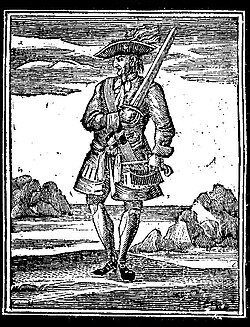Capture of John "Calico Jack" Rackham
This article includes a list of general references, but it lacks sufficient corresponding inline citations. (October 2011) |
| Capture of John "Calico Jack" Rackham | |||||||
|---|---|---|---|---|---|---|---|
| Part of the Golden Age of Piracy | |||||||
 An 18th-century woodcut of Calico Jack | |||||||
| |||||||
| Belligerents | |||||||
| | | ||||||
| Commanders and leaders | |||||||
| | | ||||||
| Strength | |||||||
| 1 sloop | 1 sloop | ||||||
| Casualties and losses | |||||||
| None | 13 captured 1 sloop captured | ||||||
The capture of John "Calico Jack" Rackham was a single-ship action fought between English pirate Calico Jack and British privateer Jonathan Barnet. The battle was fought in the vicinity of Negril, Jamaica and ended with the capture of Rackham and his crew.
Background
[edit]Rackham commanded William, a small but fast twelve-ton sloop during the action. Her armament was light, consisting of at least four cannons, and at the time of battle carried a crew of fourteen including Rackham and the pirates Mary Read and Anne Bonny. Calico Jack was originally a pirate under Captain Charles Vane, but soon after gained his own ship. In 1719, he sailed to New Providence to receive a pardon and a letter of marque from Governor of New Providence Captain Woodes Rogers. The War of the Quadruple Alliance had begun, and England hoped to make privateers of Caribbean brigands fight the Spanish. Captain Rackham was capable of receiving a pardon, but he did not receive a commission to attack the Spanish fleet.
Calico settled in New Providence, where he met Anne Bonny, but when his money was gone he returned to his life of crime.[citation needed] On August 22, 1719, Rackham and 8 other men, stole and took to the seas aboard the sloop William, in Nassau harbor.
The Governor of Jamaica, Nicholas Lawes, directed Captain Jonathan Barnet to take two sloops on a mission to hunt him down. One, Snow-Tyger, was heavily armed with several guns and carried about twenty Royal Navy sailors and some British Army troops;[citation needed] the other was Mary Anne (under former pirate Jean Bonadvis[1]) which carried about twenty men. Bonadvis was the first to spot Rackham, who fired on him; Bonadvis then retreated to report Rackham's position to Barnet, but did not further participate in the battle.[2] The encounter is remembered more for its participants than the actual combat.
Capture
[edit]On October 22, 1720,[3] Rackham's sloop was laid at anchor near Negril and fired a gun which caught the attention of Jean Bonadvis' sloop. Bonadvis reported this to Barnet who sailed to investigate the sloop. At 10 PM Barnet called out to the sloop and inquired as to who they were. The reply was "John Rackham from Cuba" and Barnet immediately ordered him to strike his colors. Someone (Barnet testified that because of it being so dark he could not identify who) replied that they would not surrender and fired a swivel gun at Barnet's sloop. Barnet ordered a broadside which destroyed the boom on Rackham's ship and his crew called for quarter.
Barnet had the men put ashore at Davis's Cove near Lucea where Major Richard James, a militia officer, placed them under arrest.[4]
Aftermath
[edit]Rackham and his crew were brought to Spanish Town, Jamaica, in November 1720, where they were tried and convicted of piracy and sentenced to be hanged. Rackham was gibbeted on Rackham's Cay at the entrance of Port Royal.[4] The remains of the other pirates were placed at various locations around the port.[4] Mary Read and Anne Bonny avoided hanging by claiming that they were pregnant, Read died several months later in April 1721, while Bonny was never heard from again.
References
[edit]- ^ Woodard, Colin (2008). The Republic of Pirates: Being the True and Surprising Story of the Caribbean Pirates and the Man Who Brought Them Down. Orlando FL: Houghton Mifflin Harcourt. ISBN 978-0547415758.
- ^ Cordingly, David (2012). Spanish Gold: Captain Woodes Rogers and the True Story of the Pirates of the Caribbean. London: A&C Black. p. 191. ISBN 9781408822166. Retrieved 26 July 2017.
- ^ Baldwin, Robert. "The Tryals Of Captain John Rackham and Other Pirates". Internet Archives. 1721, p. 31. "...on the 22d Day of October, in the feventh Year of the Reign of our faid Sovereign Lord the King, that now is, upon the high Sea, in a certain Place, diftant about one League from Negril-Point, in the Island of Jamaica, in America, and within the Jurisdiction of this Court ; did piratically and felonioufly, go over to, John Rackam...". Retrieved 11 May 2024.
- ^ a b c The Tryals of Captain John Rackham and other Pirates (Jamaica, 1721) pg 16.
- A General History of the Pyrates by Captain Charles Johnson (1724)
- Pringle, Peter, Jolly Roger: The Story of the Great Age of Piracy, Dover Publishing Company (2004)
- Lord Archibald Hamilton "An answer to an anonymous libel, entitled Articles exhibited against lord Archibald Hamilton, late governour of Jamaica" (1718)


 French
French Deutsch
Deutsch